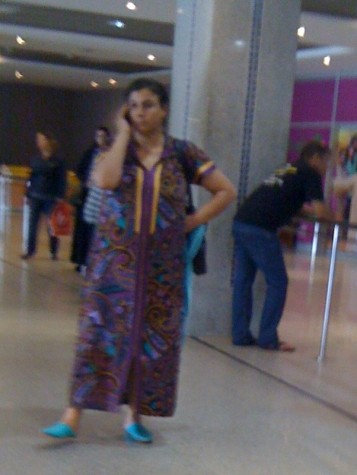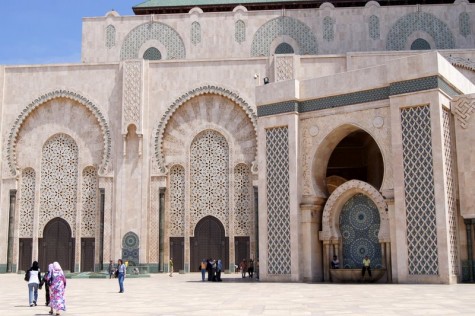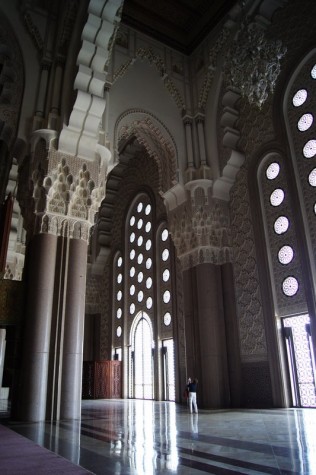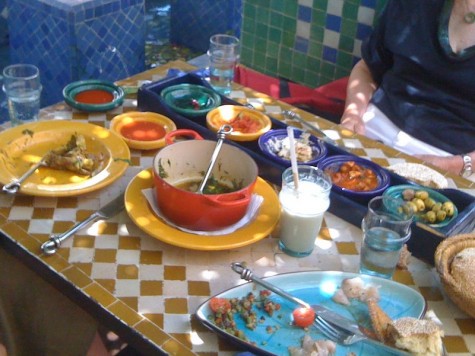But especially in a still-very-traditional place like Morocco, it’s interesting to go to the modern place and see just what details are preserved. As I’ve written about Cancun, in a newish city, you can see what people value because it’s there by choice, not just hundreds of years of accreted habit.
So Casablanca has hammams. And it has a little medina. And it has a modern medina, the Quartier Habous, a winding-streets area built by the French. (This, I suppose, is a better reflection of what the French valued in Moroccan culture than what the Moroccans themselves do.) It has loads of cafes. It even has honest taxi drivers, a rare thing anywhere in this world.
And it has plenty of people dressed in djellabas, the long robes with hoods that both men and women wear (with differing levels of decoration). This shouldn’t be a big surprise, but when you see old men in djellabas shuffling along old medina alleyways, it can all seem a little…put on, you know? You get that creeping sense, maybe born of watching too many movies or something, that somehow a place is just an elaborate bit of stagecraft put on solely for your benefit.
But in Morocco, they’re not messing around. People really do wear traditional clothing because they like it–and have adapted it to modern needs. Women color-coordinate their babouches (leather slippers) with their djellaba trim and their headscarves, and they can ride a moped in a djellaba just fine.

And when it rains, they can put up the hood. That’s what it’s for–it’s not just some vestigial bit of tradition.
Anyway, enough about fashion. Casablanca is fun, and you shouldn’t miss it, especially if you like Art Deco architecture. (And trams! They’re adding a tram line! Very exciting!) The whole French-built center is chock-full of old-fashioned bars and cafes with foggy mirrors and even foggier-looking old men. The tiny medina is still there, selling knock-off sneakers and vegetables. The sea is all around.
Other than that, there’s only one real thing to see. One of the things I like about Morocco, honestly, is that non-Muslims typically aren’t allowed in mosques. From a religious standpoint, that strikes me as slightly precious, but from a lazy tourist standpoint, it’s a huge relief–it knocks so much sightseeing right off my list! But there’s one mosque everyone’s welcome in, and that’s the Hassan II monster, right on the sea in Casablanca.
Photos can’t quite convey how large the thing is. Here’s one. Make sure you appreciate how tiny the people are. The whole mosque is like one of those sight-gag over-large chairs that make anyone who sits in them look like a kid.
Our guide said the mosque was built over six years by about 10,000 artisans working 24 hours a day, 7 days a week. Even if I’m misremembering the numbers a bit (likely), is there any comparable building erected in the modern era? The level of craftwork is boggling, straight out of the middle ages.
Once you’re done being boggled by that, you can walk (slowly, if it’s a hot day) to Sqala for lunch. Or you can go to the mosque in the afternoon (2pm is the last tour of the day), and then wander over to Sqala and get an early start on dinner. Or you could go to Sqala for lunch, wander around the medina behind it, and come back for dinner. I’m putting so much thought into the timing of this because I would gladly eat there two, even three times in one day.
Sqala in itself is reason to go to Casablanca. You know how I was complaining about how all Moroccan restaurants have the same five things on the menu? At Sqala, all the treats are out: special juices (date, almond, orange-blossom water, for instance), all kinds of nifty salads, a million little sweets, and tagine combos I’ve never seen elsewhere.
We had a salad spread that included something conch-ish (abalone?) in a tomato sauce, green olives with chicken livers, an incredibly fluffy eggplant thing and something that was so tasty we ate it all, so it doesn’t show up in the photo and I can’t remember what it is. I’m crushed.
We also had a little stew with lamb, saffron, dill and what I thought were regular-but-exceptionally-good mushrooms but I now realize were so-called “desert truffles” (terfes). I had them in Syria a couple of years ago, and thought they were tasty but not tremendous. Here they were wonderfully firm and earthy, but also a bit light and springy. Maybe the Syrian ones weren’t so hot because they’d actually been imported all the way from Morocco that year, due to a bad crop in Syria.
I could go on. The setting here is beautiful, in a courtyard with fountains, under dappled shade. The place is filled with families, and the children are all well behaved. The prices are reasonable.
Another thing you could do to kill time between meals at Sqala is go see a film at the Rialto cinema, which has been beautifully restored. Just about everything is dubbed into French, but if something with enough explosions is playing, it shouldn’t matter. Or you could have a drink at the Hotel Transatlantique, where Edith Piaf once lived for a stretch. It’s not quite as down-at-the-heels as I’d like, but it’s hard to complain about any renovation in Casablanca, where the fabulous architecture is all in need of love and repair. Or you could just ride the tram to the end of the line and back–that’s what I intend to do next time I visit.
Recommended reading for your Casa visit: The Caliph’s House: A Year in Casablanca, by Tahir Shah, and The Honored Dead: A Story of Friendship, Murder, and the Search for Truth in the Arab World
, by Joseph Braude.


